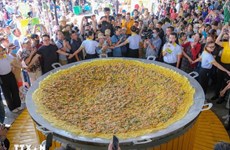Xoan singing – a unique folk treasure
Vietnam has been working on a dossier of Xoan singing, a folk strain
of northern Phu Tho province, to be submitted to UNESCO for recognition
as an “Intangible Cultural Heritage in need of Urgent Protection”.
Vietnam has been working on a dossier of Xoan singing, a folk strain
of northern Phu Tho province, to be submitted to UNESCO for recognition
as an “Intangible Cultural Heritage in need of Urgent Protection”.
Xoan singing, a vocal art of villages in the ancestral land of Phu Tho, is usually performed in front of the communal house during the village festivals in the spring. Based on legends and historical, archeological and social records, researchers say that Xoan singing first appeared a long time ago, from the time when the Hung Kings established the nation.
Associate Professor and artist Tu Ngoc said, “Xoan singing itself features a wider variety of traditional cultural rituals than other forms of ceremonial performances and cultural customs in the northern midland and delta region such as rituals for worshipping ancestors, the tutelary god of the village, the god of the soil or national heroes who made great contributions to national culture and struggles against foreign invaders”.
The mixture of different layers of rituals in Xoan singing performances indicates that the genre has had a long history of development, the artist added.
According to statistics released by folk art researchers in Phu Tho province, Xoan singing is now performed in 17 village festivals in the province. Xoan singing artists are organised into troupes, called the Xoan troupes. Each troupe consists of 12-18 young artists aged from 18-20 led by a middle-aged man who understand the rules, songs and ancient Nom script as well as how to properly organise the troupe and train the artists.
The performers only practise their skills in spare time and do not consider it a means of earning a living.
Phu Tho province now has four Xoan singing art troupes, namely Phu Duc, Kim Doi, Thet and An Thai.
There are two parts of Xoan singing, including ceremonial singing and festive singing, which have different contents and are performed in different ways.
The ceremonial singing has simple but solemn rhythm and melody representing wishes for peace, prosperity and favourable weather conditions. Meanwhile, the festive singing is more exciting and romantic in lyrics, music and dance, depicting four seasons of the year: spring, summer, autumn and winter, love, and aspirations and dreams of people.
Compared to other forms of folk art, Xoan singing has more creative, diversified and plentiful rhythm and the performance is enhanced by drums and castanets.
Although it is annually performed at the Hung Kings’ Temple Festival , Xoan singing is at risk of falling into oblivion due to erratic transmission through generations. At present, Phu Tho province has 69 Xoan singing artists but only eight of them can teach the art for following generations. Only 49 out of 81 people joining Xoan singing art troupes knew how to sing Xoan songs.
According to Prof. Dr. To Ngoc Thanh, President of the Vietnam Folk Art Association, to surmount this situation, authorised agencies should restore the original space for Xoan singing performances and have policies to encourage high schools to put the art into their teaching programmes.
Sharing views with Thanh, researcher Dang Hoanh Loan proposed a model of preservation of the Xoan singing heritage in communities, thus raising public awareness of protecting the heritage./.
Xoan singing, a vocal art of villages in the ancestral land of Phu Tho, is usually performed in front of the communal house during the village festivals in the spring. Based on legends and historical, archeological and social records, researchers say that Xoan singing first appeared a long time ago, from the time when the Hung Kings established the nation.
Associate Professor and artist Tu Ngoc said, “Xoan singing itself features a wider variety of traditional cultural rituals than other forms of ceremonial performances and cultural customs in the northern midland and delta region such as rituals for worshipping ancestors, the tutelary god of the village, the god of the soil or national heroes who made great contributions to national culture and struggles against foreign invaders”.
The mixture of different layers of rituals in Xoan singing performances indicates that the genre has had a long history of development, the artist added.
According to statistics released by folk art researchers in Phu Tho province, Xoan singing is now performed in 17 village festivals in the province. Xoan singing artists are organised into troupes, called the Xoan troupes. Each troupe consists of 12-18 young artists aged from 18-20 led by a middle-aged man who understand the rules, songs and ancient Nom script as well as how to properly organise the troupe and train the artists.
The performers only practise their skills in spare time and do not consider it a means of earning a living.
Phu Tho province now has four Xoan singing art troupes, namely Phu Duc, Kim Doi, Thet and An Thai.
There are two parts of Xoan singing, including ceremonial singing and festive singing, which have different contents and are performed in different ways.
The ceremonial singing has simple but solemn rhythm and melody representing wishes for peace, prosperity and favourable weather conditions. Meanwhile, the festive singing is more exciting and romantic in lyrics, music and dance, depicting four seasons of the year: spring, summer, autumn and winter, love, and aspirations and dreams of people.
Compared to other forms of folk art, Xoan singing has more creative, diversified and plentiful rhythm and the performance is enhanced by drums and castanets.
Although it is annually performed at the Hung Kings’ Temple Festival , Xoan singing is at risk of falling into oblivion due to erratic transmission through generations. At present, Phu Tho province has 69 Xoan singing artists but only eight of them can teach the art for following generations. Only 49 out of 81 people joining Xoan singing art troupes knew how to sing Xoan songs.
According to Prof. Dr. To Ngoc Thanh, President of the Vietnam Folk Art Association, to surmount this situation, authorised agencies should restore the original space for Xoan singing performances and have policies to encourage high schools to put the art into their teaching programmes.
Sharing views with Thanh, researcher Dang Hoanh Loan proposed a model of preservation of the Xoan singing heritage in communities, thus raising public awareness of protecting the heritage./.













